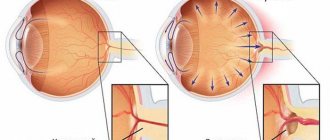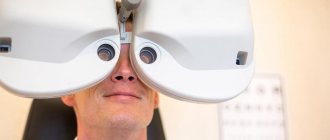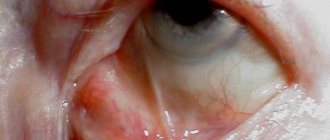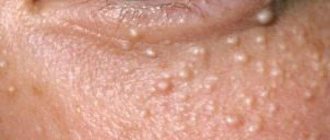Posterior capsular cataract is a pathology in which darkening of the lens of the subcapsular part, located in the posterior region of the eyeball, is observed. Posterior capsular cataract is a complicated type of disease. This pathology develops quickly, sometimes a few months are enough for a person to lose vision. The pathology can manifest itself in one eye and occur in conjunction with other diseases. In rare cases, cataracts are found in both eyes. This type of cataract can develop in people of any age group. However, in women, posterior capsular cataracts manifest themselves more aggressively. It can appear for no reason in young people aged 25 to 40 years who have never had vision problems. There are a small number of people with a congenital form of the disease. If the disease is not detected in time and treatment is not started, it will lead to loss of vision and disability.
Stages and forms of the disease
The following forms are typical for posterior capsular cataracts:
- initial form;
- immature cataract;
- mature form;
- overripe form.
In the initial form, obvious disturbances do not appear; blurred vision periodically occurs. A sick person complains of double vision, spots, and streaks before the eyes. Vacuoles filled with liquid begin to form under the capsule. These changes can be detected by biomicroscopic examination. The initial form lasts for a different period of time - from several months to a year or more.
Immature (swelling) cataracts are characterized by serious changes in the lens. A person's vision is significantly reduced. The lens itself becomes larger and occupies more volume of the eye. The pupil takes on a gray-white hue. This is accompanied by pain and increased intraocular pressure. The immature form of cataract quickly develops into a subsequent form.
In the mature form, all the unwanted symptoms of the disease appear. There is dehydration of the lens. It becomes smaller, thickens and frees the anterior chamber. A person has difficulty distinguishing colors and objects, but still sees light rays. A gray cloudiness appears in the pupil area. At this stage, surgery is performed to remove and replace the lens.
During the period of the overripe form, a person completely loses vision and becomes completely blind. The lens liquefies and becomes milky white. A small remnant of the nucleus remains, and the capsule is covered with cholesterol plaques.
Mechanism of development and statistics of the disease
Structure of the lens
Cataract is a disease whose main symptom is clouding of the lens. It is a kind of transparent spherical body in the form of a biconvex lens, having different radii of anterior and posterior curvature. The lens is located behind the pupil between the iris and the vitreous body of the eye and is covered with a transparent elastic shell (capsule) that protects the contents from external damage.
Inside, the capsule is filled with a structural protein substance (crystalin), dense in the center (core) and looser at the periphery (bark). The ground substance is a layer of growing epithelial cells that form fibers directed toward the center. The lens refracts light rays and concentrates them on the retina of the eye.
Subsequent physical and biochemical processes cause irritation of nerve endings, from which impulses travel along the optic nerves to the cerebral cortex, where a clear image of the objects in front of us is formed.
The physiological norm for the condition of the lens is its transparency and elasticity. Depending on the change in distance to an object, it can instantly change its shape. As a result of this, the radii of its curvature and the refractive power of the light beam (accommodation) decrease or increase. This is how the image is focused on the macula of the retina. Due to these continuous processes, a person sees equally well at close and distant distances.
The chemical composition of the lens, washed by the intraocular fluid, is proteins, mineral elements and water. It is not supplied with blood vessels, nerve cells and fibers. Intraocular fluid is constantly produced in the eye. Through it, metabolic processes are carried out in the lens, that is, the necessary elements are delivered and metabolic products are carried away.
Ongoing violations
Various causes of cataracts, which are mentioned below, lead to metabolic disorders, accumulation of free radicals and breakdown products, destruction of protein structures with a decrease in the transparency of the capsule and lens substance.
Deterioration of vision after 37–40 years occurs as a result of a decrease in the elasticity of the lens and its ability to accommodate, which leads to the need for the selection of corrective glasses or lenses.
Age-related clouding occurs (presumably) as a result of the same general aging processes of the whole organism - metabolism (decay) increasingly prevails over regeneration (restoration).
Damage to fibers and the accompanying biochemical processes occur in connective, cartilage and bone tissues. Osteochondrosis and arthrosis occur, in the skin - the breakdown of collagen fibers and a decrease in the content of hyaluronic acid lead to a decrease in its elasticity, the appearance of sagging, the formation of wrinkles and folds.
The appearance of symptoms of eye cataracts indicates a decrease in the transparency of the lens structures and a deterioration or complete loss of their ability to adequately transmit light rays.
Statistics
According to the World Health Organization, about 17 million people worldwide suffer from cataracts, and in 20 million they cause complete loss of vision, accounting for 50% of all cases of blindness. If earlier this disease was considered a disease of elderly people, in recent years this diagnosis is increasingly being made at the age of 40.
The development of the disease after 65 years of age was observed in 75% of people, regardless of gender. In 2012, about 15 million cataract operations were performed in the world, in Russia - 375 thousand operations, which is significantly less than the real need (due to the previous tactics in terms of timing of cataract treatment). In 33%, the disease in childhood is associated with congenital pathology.
Australian scientists conducted one study of patients diagnosed with cataracts, some of whom underwent cataract surgery from 1992 to 2007. Studying the longevity and mortality rate of 350 study participants over 49 years old with a diagnosis of cataracts, the following were taken into account: the patient’s age, body mass index, bad habits, chronic diseases - diabetes, hypertension, diseases of the cardiovascular system, etc.
The results of a study conducted by Australian scientists showed that among 2 groups of patients (one underwent surgery to remove cataracts and vision correction, the other group with cataracts did not) in patients who underwent surgery, mortality and morbidity were 40% lower than in that group. group that did not undergo this procedure. The results of this study show that vision correction has a positive effect on the longevity and quality of life and general well-being of the elderly.
Causes
The leading factors in the manifestation of posterior capsular cataracts are:
- taking corticosteroid drugs for a long period of time;
- the presence of a pathology such as diabetes mellitus, which greatly increases the risk of bilateral damage to the organs of vision;
- diseases of the visual organs: uveitis, glaucoma, dystrophy develop into complicated cataracts;
- mechanical destruction of the lens - any injury to the organs of vision or head can provoke pathological changes in the lens; in this case, moisture gets inside and causes its swelling;
- carrying out surgical interventions in the field of ophthalmology, appears in the form of an exacerbation after surgery;
- aggravation after various diseases of the body;
- cerebral atherosclerosis;
- genetic predisposition;
- harmful working conditions, severe poisoning with thallium, mercury;
- radioactive, ionizing or ultraviolet radiation;
- psoriasis and skin cancer;
- bad habits - alcohol abuse, smoking.
Causes of nuclear cataract formation
Many years of research have been conducted to study this disease. The statistics obtained allow us to talk about the causes of the disease, including the aging of the body and related processes, as well as the undeniable influence of external factors. In general, we can talk about the following main reasons for the development of the disease:
- Physico-chemical changes observed in the human body over the years, and oxidative stress (transition of proteins to insoluble fractions due to lack of nutrition and the associated oxidation process)
- Heredity, which in some cases leads to the appearance of nuclear cataracts at an earlier age
- Effects of radiation, infrared radiation and ultraviolet radiation
- Damage and injury to the eyeball
- Bad habits (the undoubted influence of alcohol and tobacco smoke on the development of the disease has been proven)
- Improper metabolism and excess weight
- Previous diseases (in some cases, patients develop nuclear cataracts after typhus or malaria)
- An additional impetus for the development of the disease can be the use of certain medications for a long time (neuroleptics, corticosteroids, etc.)
- Statistics allow us to draw conclusions about the impact of other chronic diseases (hypertension, diabetes, allergies, thyroid diseases, etc.) and ophthalmological diseases
- Poor diet and iodine deficiency
Return to contents
Signs and symptoms
It is very difficult to identify cataracts in their initial form on their own. Especially if the symptoms of the disease do not appear. The main indicators of the presence of this pathology are described below:
- vision deteriorates at close range - it gradually decreases at long distances;
- part of the field of view in the center of the image disappears;
- in the dark, flashes or glare may occur;
- the fear of light progresses - photosensitivity increases significantly, but pain is not observed;
- the image may double;
- color perception deteriorates;
- multiple changes of contact correction means, posterior capsular cataract is difficult to correct with glasses;
- perhaps the appearance of severe headaches, pain syndrome and inflammatory processes in the organs of vision.
Cataracts occur differently in all patients and have different rates of development. Over time, visual function may lose clarity and disappear completely. If the above symptoms appear, you should consult a doctor to make a diagnosis. You cannot self-medicate and ignore such symptoms.
Diagnostics
If symptoms of posterior capsular cataract appear, you should urgently consult an ophthalmologist. He will interview the patient about the symptoms and conduct the necessary studies:
- First of all, biomicroscopy is performed. It helps the doctor examine the fundus of the eye, changes in structure or structure.
- Using a special device, they check the curvature of the cornea, the condition of the lens, and the parameters of the eye.
- Using a slit lamp, the extent of the disease is determined. The mature form of the pathology is best diagnosed.
- If necessary, an examination of the optic nerve and retina using ultrasound is prescribed.
Based on the examination results, the ophthalmologist will be able to make an accurate diagnosis and decide on the treatment method.
Visual acuity can be restored after surgery.
Stages of nuclear cataract
The disease becomes more complicated gradually, moving from one stage to another. This process takes several years, during which the following changes can be observed:
- At the beginning, the nucleus remains transparent for the most part, with only small scattered areas of turbidity noted. At this time, a person sees well, noticing increased eye fatigue.
- The next stage (immature cataract) differs from the first form in that small cloudy areas join together to form a wide cloudy area in the core. At this time, the patient notes a strong drop in vision, because the cloudy area does not allow light to easily reach the retina.
- At the stage of mature cataract, not only the nucleus, but also the entire lens loses its transparency. During this period, the patient can perceive bright light, but over time he loses this ability.
- The final stage (overmature cataract) is characterized by complete degradation of the lens. If treatment is not started before this point, the patient will go blind forever.
Treatment
It is possible to get rid of posterior capsular cataract only through surgery. Surgery takes place in one of two ways:
- Intracapsular cataract extraction. This method of treatment is used in exceptional cases, since the eyeball is highly injured. The operation is performed using a special device – a cryoextractor. Using this device, the lens and capsule are frozen to a metal tip, then removed through a previously made incision.
- Extracapsular cataract extraction. The clouded lens is removed using a microcut and replaced with an intraocular lens. It is possible to remove only the damaged part. This maintains a barrier between the vitreous and the front of the eyeball. This method of treatment has a disadvantage - significant damage to the organ of vision is observed.
These methods of treating posterior capsular cataracts allow for partial or complete replacement of the lens. After the operation, a bandage is applied to the eyes of the operated person. It reduces the risk of complications or infection.
Healing after surgery occurs within 7-10 days. During this period, the patient is prescribed antiseptic drops and antibiotics. Compliance with all doctor’s recommendations promotes the fastest healing and restoration of visual function. Most often, vision returns by 90-100%.
Prevention
You can reduce the risk of developing posterior capsular cataracts by following preventive measures:
- maintaining a healthy lifestyle;
- rejection of bad habits;
- protecting eyes from injury and negative environmental influences;
- preventive intake of vitamins;
- annual medical examination.
Posterior capsular cataracts can lead to blindness and disability. Therefore, it is necessary to carry out surgical treatment as early as possible.
What do you know about posterior capsular cataracts? Share in the comments. Repost on social networks. Take care of your eyesight. Be healthy.











